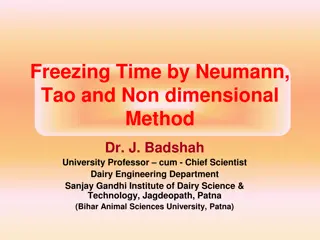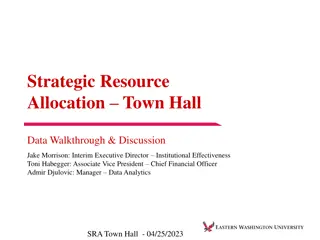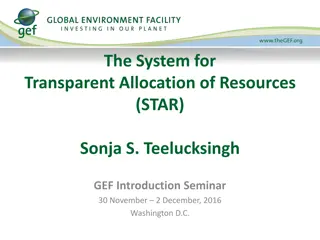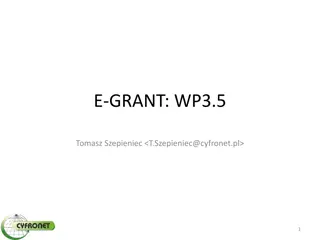IEEE 802.11-23/1953r0 Two-Dimensional Resource Allocation (UL OFDMA)
Introducing a novel approach for uplink transmissions in UHR to achieve low-latency communication. The document discusses UL OFDMA in detail, emphasizing the use of a two-dimensional resource unit. Key topics covered include UL MU operation, UL OFDMA-based random access, and allocation of RUs for random access scenarios.
Download Presentation

Please find below an Image/Link to download the presentation.
The content on the website is provided AS IS for your information and personal use only. It may not be sold, licensed, or shared on other websites without obtaining consent from the author.If you encounter any issues during the download, it is possible that the publisher has removed the file from their server.
You are allowed to download the files provided on this website for personal or commercial use, subject to the condition that they are used lawfully. All files are the property of their respective owners.
The content on the website is provided AS IS for your information and personal use only. It may not be sold, licensed, or shared on other websites without obtaining consent from the author.
E N D
Presentation Transcript
November 2023 doc.: IEEE 802.11-23/1953r0 Two Dimensional Resource Allocation (UL OFDMA) Date: 2023-09-11 Authors: Name Affiliations Address Phone email Srinivas Kandala Samsung srini.k1@samsung.com Vamadevan Namboodiri Samsung devan.n@samsung.com Mark Rison Samsung m.rison@samsung.com Myeongjin Kim Samsung mj1108.kim@samsung.com Submission Slide 1 Srinivas Kandala, Samsung
November 2023 doc.: IEEE 802.11-23/1953r0 Introduction One of the main objectives in UHR is low latency as described in UHR proposed PAR document [1]. Various latency reduction technologies were introduced in many UHR contributions [2-9]. We briefly introduced two dimensional (2D) resource unit for uplink transmissions in [2] as one of solutions to allow transmitting latency-sensitive data in the middle of ongoing TB PPDU. In this contribution, we discuss an uplink two dimensional resource allocation (UL OFDMA) in more detail. Submission Slide 2 Srinivas Kandala, Samsung
November 2023 doc.: IEEE 802.11-23/1953r0 Recap: UL OFDMA UL MU operation allows an AP to solicit simultaneous immediate response frames from one or more non-AP HE STAs. Trigger Frame Multi-STA Block ACK AP SIFS SIFS RU1 (non-AP STA1) RU2 (non-AP STA2) RU3 (non-AP STA3) HE TB PPDU Submission Slide 3 Srinivas Kandala, Samsung
November 2023 doc.: IEEE 802.11-23/1953r0 Recap: UL OFDMA-based random access (UORA) An HE AP may transmit a Basic Trigger frame, BQRP Trigger frame or BSRP Trigger frame that contains one or more RUs for random access. An AP that transmits a Trigger frame that is not a Basic Trigger frame shall not set the AID12 subfield of any User Info field of the frame to indicate allocation of one or more RA-RUs for unassociated STAs. An AP that transmits a Trigger frame that is not a Basic Trigger frame, BQRP Trigger frame or BSRP Trigger frame shall not set the AID12 subfield of any User Info field of the frame to indicate allocation of one or more RA-RUs for associated STAs. Submission Slide 4 Srinivas Kandala, Samsung
November 2023 doc.: IEEE 802.11-23/1953r0 Recap: UL OFDMA-based random access (UORA) An HE AP may allocate a contiguous set of RUs for random access by setting the Number Of RA-RU subfield in the User Info field of the Trigger frame to a value greater than 1. The RA-RU indicated by the RU Allocation subfield in the User Info field shall represent the starting RU of the set. The size of all RA-RUs in the set shall be the same and equal to the size of the RA-RU indicated by the RU Allocation subfield in the User Info field. The remaining subfields of the User Info field apply to each RA-RU in the set. An AP allocating a contiguous set of RA-RUs in a Trigger frame with an UL BW subfield that indicates 80+80 MHz or 160 MHz shall set the Number Of RA-RUs subfield such that all the RA-RUs in the set lie in one 80 MHz frequency segment. Submission Slide 5 Srinivas Kandala, Samsung
November 2023 doc.: IEEE 802.11-23/1953r0 Recap: UL OFDMA-based random access (UORA) Submission Slide 6 Srinivas Kandala, Samsung
November 2023 doc.: IEEE 802.11-23/1953r0 Recap: Trigger frame format (1/2) Submission Slide 7 Srinivas Kandala, Samsung
November 2023 doc.: IEEE 802.11-23/1953r0 Recap: Trigger frame format (2/2) Submission Slide 8 Srinivas Kandala, Samsung
November 2023 doc.: IEEE 802.11-23/1953r0 Problem In .11ax and .11be TB PPDU, AP can assign a resource only in a frequency domain. When AP knows non-AP STA has data to send, then it allocates resource to a certain resource unit. If AP does not know, and if it is time sensitive packet, then non-AP STA can transmit the data packet through RA-RU (if it is allocated). When time sensitive packet arrives after the TB PPDU started, then the non-AP STA needs to wait for next opportunity. Submission Slide 9 Srinivas Kandala, Samsung
November 2023 doc.: IEEE 802.11-23/1953r0 Two Dimensional Resource Unit We want to allow transmitting latency sensitive PSDU in the middle of on- going TB PPDU so that we can reduce latency Random access can be used for this purpose Example of a two dimensional resource unit TB-PPDU: Indicated by the trigger frame Traffic arrives Trigger Frame Multi-STA Block ACK AP SIFS SIFS RA-RU 1.2 LTF STF RA-RU 1.1 (Latency Sensitive PSDU) RU2 (non-AP STA2) Preamble RU3 (non-AP STA3) TB PPDU STAs that transmit the RA-RU should expect acknowledgement in the Multi-STA Block Ack and shall be SIFS after TB PPDU transmission Submission Srinivas Kandala, Samsung Slide 10
November 2023 doc.: IEEE 802.11-23/1953r0 Transmission Format Regular TB PPDU Format If there are follow-on RUs, then no need to append PE. Structure of later resources DATA LTF STF PE Unlike start/first position (SIFS after the trigger frame), we don t need to have L-STF/L-LTF/L- SIG/RL-SIG/HE-SIG-A/U-SIG. These fields are for other STA that may hear the PPDU so that they can defer the transmission. Start from EHT (or UHR) STF and LTF. Symbol duration for STF shall be same as other data symbols. Submission Slide 11 Srinivas Kandala, Samsung
November 2023 doc.: IEEE 802.11-23/1953r0 Trigger Frame RA-RU Information in User Info field In .11ax and .11be, it indicates the number of contiguous RA-RUs allocated for UORA and the more RA-RU information. In case of UORA, the RU Allocation subfield in the User Info field shall represent the starting RU of the set. There are several options to indicate two dimensional resource unit Option1. Indicate number of time domain resource unit in common info field. Option 2. Indicate number of time domain and frequency domain resource unit in the RA-RU Information, e.g. First one or two MSBs indicates number of time domain resource unit while other bits to indicate number of contiguous RA-RUs (frequency domain) allocated for UORA. Option 3. Using reserved or other bits to indicate number of time domain resource unit. Submission Slide 12 Srinivas Kandala, Samsung
November 2023 doc.: IEEE 802.11-23/1953r0 Number of OFDM Symbols The time domain resource is divided by the number of time domain resource unit. For example, if the number of data OFDM symbol is NSYM (indicated by L- Length and other variables (refer below 36-93)) and number of time domain resource unit is K, then floor((NSYM -(H*(K-1)))/K) where H is number of non- data for each later RA-RU. In the example in previous slide, H = 2 when number of LTF is 1 and number of STF is 1. When there are multiple RA-RUs in time domain, only last RA-RU in the time domain will append PE and remaining of unused symbols, which is NSYM H*(K-1) K*floor((NSYM -(H*(K-1)))/K). In this case, unused symbols can be modulated same as PE. Alternatively, first RA-RU in time domain may include NSYM H*(K- 1) K*floor((NSYM -(H*(K-1)))/K) more symbols than later RA-RU. Submission Slide 13 Srinivas Kandala, Samsung
November 2023 doc.: IEEE 802.11-23/1953r0 Summary and Conclusions Introduced the concept of two dimensional PPDU, where RUs are not only assigned in frequency domain but also in time domain for uplink transmissions Having the ability for a STA to access an RA in the middle of PPDU would enable transmission of late-arriving low-latency MSDUs to be transmitted in a timely manner Use of UORA allows random access of the STAs that may not have been originally granted an RU within the PPDU Submission Slide 14 Srinivas Kandala, Samsung
November 2023 doc.: IEEE 802.11-23/1953r0 Straw Poll Are you in favor of supporting the concept of two dimensional PPDUs for uplink transmissions in TGbn? Yes: No: Abstain: Submission Slide 15 Srinivas Kandala, Samsung
November 2023 doc.: IEEE 802.11-23/1953r0 Reference [1] 11-23/0480r3, UHR Proposed PAR [2] 11-22/1393r0, Latency Reduction Scheme for UHR [3] 11-20/674r3, Forward Compatible OFDMA [4] 11-20/693r1, Aggregated PPDU for Large BW [5] 11-21/670r0, Further Improve Latency Performance in 11be [6] 11-23/1229r1, Preemption for low latency application (Follow up) [7] 11-23/1174r0, TXOP preemption follow up [8] 11-23/1194r0, Overlapped indication to support preemption [9] 11-23/1242r1, Considerations on Inter-PPDU based Preemption Scheme Submission Slide 16 Srinivas Kandala, Samsung























